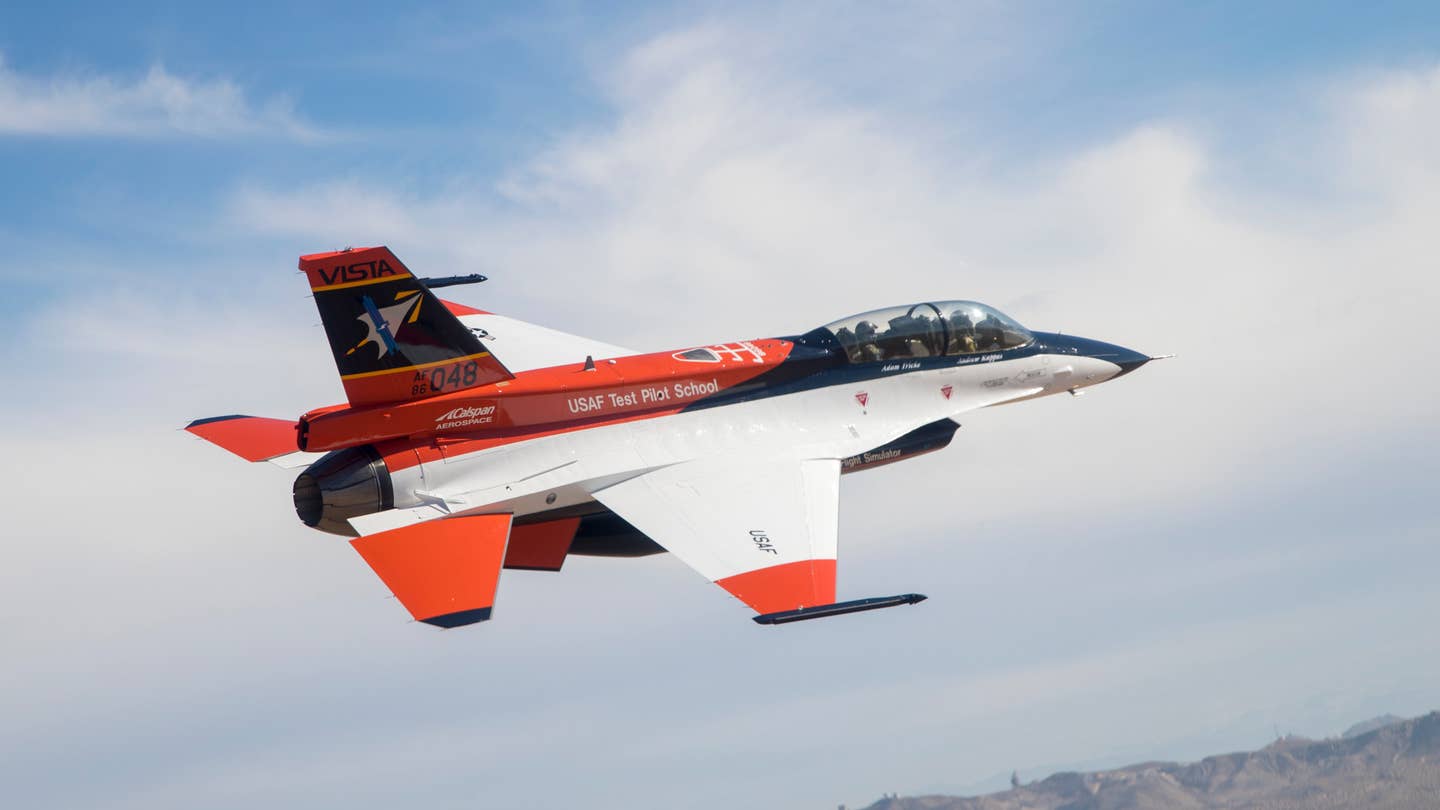DARPA Achieves Major Breakthrough with AI-Controlled Aircraft
The agency says successful AI dogfighting trials could support the use of autonomous systems in other complex scenarios.

U.S. Air Force test pilots combatted the DARPA-developed X-62A VISTA, a modified AI-controlled F-16, during dogfighting demonstrations. [Courtesy: DARPA]
The Defense Advanced Research Projects Agency, or DARPA, is a branch of the U.S. Department of Defense developing ambitious, outlandish aircraft designs, such as an airplane with no control surfaces or the Liberty Lifter seaplane. On Wednesday, the agency released critical details on what may be its most groundbreaking program so far.
For the past four years, DARPA has been developing its Air Combat Evolution (ACE) program, which seeks to team human pilots with AI and machine-learning systems in dogfighting scenarios. According to the agency, the initiative reached new heights in September with the first AI-versus-human dogfight conducted with actual aircraft.
During the test campaign, the agency says, the AI made no violations of training rules codifying airmen’s safety and ethical norms. In other words, it flew just as safely as a human pilot.
DARPA called the achievement “a fundamental paradigm shift,” similar to the inception of AI computers that can defeat human opponents in a game of chess. Chinese military researchers reportedly achieved a similar feat in March 2023, with one aircraft operated by AI and another controlled by a human on the ground.
Researchers also “pioneered new methods to train and test AI agent compliance with safety requirements, including flight envelope protection and aerial/ground collision avoidance, as well as with ethical requirements including combat training rules, weapons engagement zones, and clear avenues of fire,” the agency said.
This is significant because, according to DARPA, previous integrations of autonomy on crewed commercial and military aircraft have used heuristic or rules-based systems, which are designed for situations that are predictable or repeatable. More complex scenarios such as dogfighting are impractical for such a model because there are simply too many possibilities for which designers must account.
Machine-learning AI models are less predictable and explainable than rules-based models. But they are excellent for analyzing complex scenarios on the fly.
DARPA views AI dogfighting as “a means to an end,” in the sense that it intends for its findings to be applied to AI integration on military aircraft more broadly. Another goal is to foster trust in pilots toward machines. The idea is that if autonomy can operate in a scenario as dangerous as close-quarters combat, humans can trust it to work in less dangerous—but equally complex—situations.
“What is the most efficient and effective path to optimize the performance and safety of artificial intelligence in aerospace vehicles?” is the question the agency poses.
To evaluate AI for dogfighting, engineers developed the X-62A, a modified F-16 test aircraft also known as the Variable In-flight Simulator Test Aircraft (VISTA). Uniquely, VISTA is capable of simulating the conditions of other aircraft while flying.
“Think of a simulator laboratory that you would have at a research facility,” said Bill Gray, chief test pilot at the U.S. Air Force Test Pilot School at Edwards Air Force Base (KEDW) in California. “We have taken that entire simulator laboratory and crammed it into an F-16, and that is VISTA.”
Personnel began in 2020 by testing AI systems in a simulated environment using computers, progressing over the course of 21 test flights to actual flight controlled by ACE algorithms. Two human pilots remained in the cockpit for safety purposes.
The AI was retrained on a daily basis—engineers updated flight control laws overnight and reprogrammed the aircraft to fly the following morning. More than 100,000 lines of software changes were made over the course of testing.
The first dogfight between a crewed F-16 and ACE-controlled VISTA took place in September. The self-flying aircraft performed both defensive and offensive maneuvers, getting as close as 2,000 feet to the crewed aircraft at 1,200 mph.
All autonomous demonstrations took place at the Air Force Test Pilot School, where DARPA says they are continuing in 2024. The hope is that the results can be repeated during future testing of other scenarios. And researchers believe they could.
“Every lesson we’re learning applies to every task we could give to an autonomous system,” said Gray.
Like DARPA, the Air Force is committed to exploring autonomous flight systems. In addition to participating in ACE, the department is developing such technologies through AFWERX, its innovation arm. Last week, Air Force Secretary Frank Kendall told U.S. lawmakers that he would get in the cockpit of a self-flying plane—which the Air Force on Wednesday confirmed to be VISTA—in the near future.
“The potential for autonomous air-to-air combat has been imaginable for decades, but the reality has remained a distant dream up until now,” said Kendall. “In 2023, the X-62A broke one of the most significant barriers in combat aviation. This is a transformational moment, all made possible by breakthrough accomplishments of the X-62A ACE team.”
Like this story? We think you'll also like the Future of FLYING newsletter sent every Thursday afternoon. Sign up now.

Sign-up for newsletters & special offers!
Get the latest FLYING stories & special offers delivered directly to your inbox






